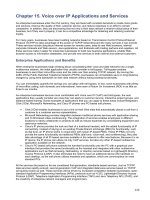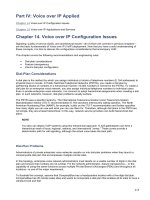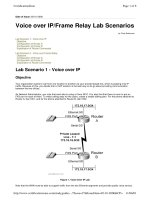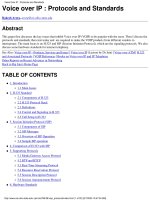Tài liệu Understanding Voice over IP Signaling Protocols in Cisco Telephony Implementations ppt
Bạn đang xem bản rút gọn của tài liệu. Xem và tải ngay bản đầy đủ của tài liệu tại đây (111.43 KB, 7 trang )
Understanding Voice
over IP Signaling
Protocols in Cisco
Telephony
Implementations
1-800-COURSES
www.globalknowledge.com
Expert Reference Series of White Papers
Introduction
Understanding the specific functions Voice over Internet Protocol (VoIP) signaling protocols perform plays a
critical role in designing, building, maintaining, and troubleshooting a Cisco VoIP implementation. Each proto-
col also plays a direct role in implementing different features, services, technologies, as well as in product
selection and integration. Specifically, Cisco has predominately implemented the following five different signal-
ing protocols amongst their rapidly expanding telephony product line:
• H.323
• MGCP (Media Gateway Control Protocol)
• Skinny (SCCP, Skinny Client Control Protocol)
• SIP (Session Initiation Protocol)
•CTI/JT
API (Computer Telephony Integration/J
ava Telephony Application Programming Interface)
What is a signaling protocol?
In a very simple sense, all telephones perform two basic functions;
signaling and audio
. When a user picks up a
phone and hears the dial tone, dials digits, another phone rings, put another on hold, create a conference call:
this is signaling. When you talk on a phone to a person, in a conference call, or are leaving or hearing voice
mail, even hearing Music on Hold (MOH):
this is audio
.
Traditional telephony, prior to the exponential growth of VoIP, performed signaling in either an analog or digi-
tal formats that still play an important role in voice gatew
ays. While VoIP signaling protocols vary from vendor
to vendor, some proprietary, others industry standard, audio is handled by one industry standard IP protocol
called Real Time Protocol (RTP). Inside, an RTP frame contains the digitized conversion of human analog voice
created from codecs (Coder-Decoder or Compress-Decompress). When bandwidth is abundantly available, as in
a LAN environment,
the Cisco IP phone default G
.711 is used in R
TP
.
When bandwidth is at a premium,
as on a
slow
WAN link,
G
.729 is used. While other codecs are supported on some Cisco products, they are falling out
of favor with designers and, thus, Cisco products as well.
In VoIP, IP phones have absolute reliance on VoIP signaling protocols. Unlike a traditional POTS (plain old
telephony service) phone at home that still works, even if the home loses power, IP phones can only function
with a
V
oIP signaling protocol,
and the ability to call anywhere needed,
further relies on
VoIP signaling proto-
cols
.
Another role of the signaling protocol is potentially to hand off the dialed number to a call agent like
CallManager or CallManager Express, which then passes off the call signaling to another signaling protocol,
ultimately to locate a phone to ring. With the emergency service 911, along with any other mission-critical or
revenue-generating calls, any intelligent IP telephony design and implementation has a critical reliance on VoIP
signaling protocols
.
Chris Olsen, Global Knowledge Instructor, CCSI, CCNA, CCNP, CCVP
Understanding Voice over IP Signaling Protocols
in Cisco Telephony Implementations
Copyright ©2007 Global Knowledge T
raining LLC. All rights reserved.
Page 2
Why Voice over IP, and what is behind its incredible growth?
A fair question from any organization with a significant existing investment in traditional PBX technology is
why to upgrade to a VoIP system, especially since the initial capital investment of VoIP can be sizeable. The
best answer is a very large potential reduction in telephony operating costs in the form of reduced toll charges
to send IP signaling and audio over existing IP WAN links. This can occur in two forms, Toll Bypass and Tail End
Hop Off (TEHO). Suppose that a call went from Chicago to San Francisco where you have another office
through a WAN link, but the destination was to another vendor in San Francisco. TEHO takes advantage of the
WAN link, but then the call goes through a San Francisco gateway incurring only a local San Francisco toll
charge. It is very common for organizations to see a full return on investment (ROI) from VoIP in a few years,
or even months, depending on call patterns.
Many additional benefits of VoIP, although potentially less tangible, have to do with all the many integrations
of VoIP possible with Internet technologies such as a concierge service in a hotel; database lookups for cus-
tomers; and information brought to the IP phone, such as weather, stock quotes, airport delays; etc.
Cisco VoIP Products
Cisco CallManager (CCM)
In 1998, Cisco acquired Selsius, which brought both CallManager and the IP phones into the telephony product
line
. CallManager is usually the heart of a Cisco VoIP implementation, as it is the “brain” of the call control
protocols to all IP telephony devices. CCM v4.x and earlier are installed on a Microsoft Windows 2000 server
and, in CCM v5.0, is installed as an appliance on a Linux server. Clustering multiple servers is used for fault
tolerance and load balancing, and can support 30,000 phones/ cluster. A future release of CCM v6.x will offer
identical features on either a Microsoft or a Linux platform, whereas, currently, CCM v4.x and 5.x have differ-
ences in feature support.
Cisco CallManager Express/Cisco Unity Express (CME/CUE)
Years after the Selsius acquisition, Cisco created CME,
which is a unique router internetworking operating sys-
tem (IOS) feature sets ability to control IP phones with Skinny
. CME is designed for small branch offices or
retail stores to replace key systems or small PBXs with a current maximum of 240 IP phones supported in the
LAN
. CME can operate totally independently of CCM, or can co-exist with signaling protocols in an organiza-
tion. CUE is separate hardware located physically in a router, which is a server running voice mail on a Linux
platform.
Cisco Unity
V
oice mail in a larger environment is handled on a Microsoft
Windows 2000 or 2003 server running Unity
.
Unified messaging, which integrates voice mail, email, and faxes in a single messaging program like Outlook,
is also available.
Cisco Unified Contact Center Express (UCCX)
Traditional telephony systems implement Automatic Call Distribution (ACD) and Interactive Voice Response
(IVR) in call center products. CCM and CME offer only very limited ACD and IVR features, not suitable for a call
center with many agents. UCCX supports both ACD and IVR with agent software and integrates directly in a
CCM environment.
Future versions may support integration directly with CME.
Copyright ©2007 Global Knowledge T
raining LLC. All rights reserved.
Page 3
VoIP Signaling Protocols in a Cisco Implementation
The VoIP industry has developed many different signaling protocols, some proprietary, some governed by the
Internet Engineering Task Force (IETF), and another from the International Telecommunication Union (ITU). The
five below, not in any particular order, are the predominant focus in a Cisco VoIP installation. Also important to
note is that all of these protocols are based on IP, thus, requiring an existing IP infrastructure to operate. Any
error in IP or relating to IP, such as convergence issues with Spanning tree protocol or the routing protocol or
flapping WAN links, will adversely affect IP telephony. One feature of IP signaling protocols is call survivability.
When an existing VoIP call has an established RTP stream, and then any failure in IP connectivity occurs
between either phones and their signaling device, such as CCM or CME, if the call stays up, there is call surviv-
ability.
H.323
H.323, like any other telephony or non-telephony protocol with the name format “letter.number,” is governed
by the ITU. In the early 1990s, the ITU changed their name from the Consultive Committee on International
Telephony and Telegraphy (CCITT [the full correct name is in French]). The origin of the CCITT actually dates
back to the original wired communication systems emanating from the telephony pioneers Samuel Morse of
the Morse code and Alexander Graham Bell of the first telephone. H.323 is, therefore, considered quite mature.
Engineers familiar with ISDN Q.931 will note many functional similarities to H.323, as they were both devel-
oped by the ITU.
Cisco implements H.323 in several formats. If an organization has two or more CallManager clusters, the logi-
cal IP connection between the clusters configured is called an Inter Cluster Trunk (ICT), which is based on
H.323.
H.323 also can be used as a signaling protocol between CCM and a voice gatew
ay. If the voice gate
-
way were not a Cisco product, H.323 would be the choice. One drawback of H.323 is that it does not support
call survivability.
If two or more voice gateways or CallManager Express routers need to send signaling to each other over an IP
network, the router configuration commands called dial peers are configured, also based on H.323. Many retail
stores
, pharmacies, doctor offices, etc. are beginning to install large numbers of CMEs in each of their loca-
tions. The number of configured dial peers needed for full connectivity requires a full mesh, from the formula:
Number of Dial Peers required = __N(N-1)
___
2
Where N is the number of CMEs, voice gateways (or even entire CCM clusters with ICTs). In a large organiza-
tion with hundreds or thousands of locations, administering and updating dial peers can be a sizeable task.
The solution to simplify management and troubleshooting is another optional H.323 component called a gate-
keeper. In essence, a gatekeeper can perform one or two functions; centralized call routing or Call Admission
Control (CA
C).
Centralized call routing allows for all of the Gateways, CMEs, or CCMs to be configured with a single dial peer
or ICT pointer to the gatekeeper. The gatekeeper contains configurations of summarized ranges of phone num-
bers found in all of the branch locations that it uses to route phone calls.
CAC serves the purpose of “protecting voice from voice.” A single G.729 call in an RTP stream takes approxi-
mately 26 kbps, while G.711 takes roughly 86 kbps, depending on the layer 2 headers. As an example, a slow
WAN connection of 300 kbps, taking into account signaling, would allow resources for roughly 10 G.729 calls,
Copyright ©2007 Global Knowledge T
raining LLC. All rights reserved.
Page 4
n
ot to mention any other user data. What if 12 calls were submitted? How about 20? By default, CCM and
CME assume infinite bandwidth everywhere and can send calls through a link that might not properly support
them. The calls will go through, but at an unacceptable degradation in voice quality will occur in the form of
clipping (pieces of voice missing) and a large audible delay. The solution is CAC, which is usually done by a
gatekeeper, CCM, or both. CAC defines the maximum calls that can go through a link and, once all those calls
are reached, additional calls are blocked or, ideally, routed through the public switched telephone network
(PSTN).
Cisco implements an H.323 gatekeeper in a router via IOS commands and a gatekeeper does not require any
unique router hardware modules, unlike a gateway. While a gatekeeper can also act as a gateway, this is rarely
done in large production environments. Gatekeepers can also be configured in a fault tolerant group of gate-
keepers called a gatekeeper cluster, different from a CCM cluster.
MGCP
Media Gateway Control Protocol (MGCP) is an Internet standard governed by the IETF, and is relatively much
newer then H.323. MGCP is a client server protocol and the “client” can be a voice gateway or a user client,
controlled by the server component referred to as a call agent. In a Cisco VoIP installation, MGCP plays one
critical role: the logical control of voice gateways by the call agent CCM. MGCP implies more configuration
steps in CCM with a minimal gatew
ay configuration making MGCP a centralized signaling protocol.
Since
CallManager Express is built to operate independently, it is not controlled directly by CallManager; therefore,
MGCP is not supported on CME, as it is not needed. CCM does not have the ability to use MGCP to non-Cisco
voice gateways.
Skinny
Skinny is not an acronym, but it is often referred to as Skinny Client Control Protocol (SCCP). Skinny is entirely
Cisco proprietary and came from the 1998 Selsius acquisition. The main function of Skinny is to control IP
phones from either a CCM cluster or CME.
If a voice gatew
ay is configured as Survival Remote Site Telephony
(SRST) to give remote phones fault tolerance to CCM in the event of a WAN failure, the remote phones will
also talk Skinny to the SRST router. Skinny is also the control protocol between CCM and Unity. In an environ-
ment with a lot of analog phones or faxes, Cisco has a few voice gateway products with the
“V
G”
designation, which are also controlled by Skinny from CCM or CME.
SIP
Session Initiation Protocol (SIP) is an IETF standard like MGCP. Just 3 years ago SIP played a relatively small
role in Cisco telephony
, but today it is gaining ground fast in new and future Cisco telephony products.
Starting with CCM v4.0, a SIP trunk can be configured to implement voice signaling to another CCM cluster, a
CME router
,
or any other non-Cisco IP telephony product that supports SIP
.
V
oice gatew
ays and CMEs can also
do SIP signaling in a dial peer to any other SIP device. One mandatory use of SIP in Cisco is between CME and
the internally installed voice mail component CUE. A big change in CCM 5.0 is the option to replace Skinny
with SIP as the phone signaling protocol.
CME v4.0 also supports SIP to the phones
. One key benefit of run-
ning SIP to the phones is that Cisco now allows support of many of the fast growing third-party SIP phones.
Cisco’s new Presence server gives users a greater ability to locate another user in the communication format
that they have av
ailable
.
T
he Presence server requires SIP with CCM v 5.0.
Copyright ©2007 Global Knowledge T
raining LLC. All rights reserved.
Page 5









